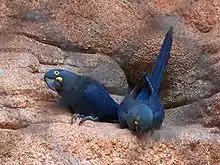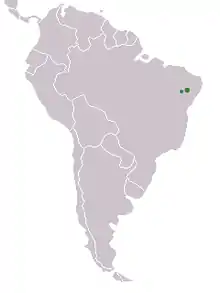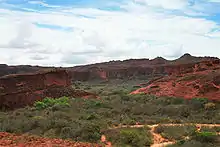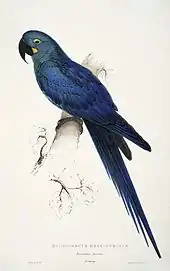Lear's macaw
Lear's macaw (Anodorhynchus leari), also known as the indigo macaw, is a large all-blue Brazilian parrot, a member of a large group of neotropical parrots known as macaws. It was first described by Charles Lucien Bonaparte in 1856. Lear's macaw is 70–75 cm (28–30 in) long and weighs around 950 g (2.09 lb). It is metallic blue with a faint, often barely visible, tinge of green, and a yellow patch of skin at the base of the heavy, black bill.
| Lear's macaw | |
|---|---|
 | |
| Scientific classification | |
| Kingdom: | Animalia |
| Phylum: | Chordata |
| Class: | Aves |
| Order: | Psittaciformes |
| Family: | Psittacidae |
| Genus: | Anodorhynchus |
| Species: | A. leari |
| Binomial name | |
| Anodorhynchus leari Bonaparte, 1856 | |
 | |
| Range is shown in green | |


.JPG.webp)
This macaw is rare with a highly restricted range. Its lifespan can exceed 30–50 years.[2]
Taxonomy
Lear's macaw was first described by French ornithologist Charles Lucien Bonaparte in 1856, but the rarely seen bird was not considered a distinct species until 1978, when ornithologist Helmut Sick finally located the wild population.[3] It was named after the poet, author, and artist, Edward Lear, who published many drawings and paintings of live parrots in zoos and collections.[3][4] One of his paintings in his book Illustrations of the Family of Psittacidae, or Parrots strongly resemble this species, although at the time it was believed to be a hyacinth macaw — a species which is larger, darker, and has a differently shaped patch of yellow skin adjacent to the base of the bill.
Description
Lear's macaw is 70–75 cm (27.5–29.5 in) long and weighs around 950 g (2.09 lb).
The body, tail, and wings are dark blue and the head is a slightly paler shade. It has an area of pale-yellow skin adjacent to the base of its beak, and orange-yellow eye rings. It has a large, blackish beak and dark grey feet.
Lear's macaw is similar to the larger hyacinth macaw and the slightly smaller glaucous macaw. The hyacinth macaw can be distinguished by its darker plumage, lack of greenish tinge, and a differently shaped patch of yellow skin adjacent to the base of the bill. The glaucous macaw is paler and has a more greyish head.[5]
.jpg.webp)
Behavior
When a group of macaws is searching for food or a new nesting ground, a small advance party of males "scouts out" the approaching terrain. In addition, when danger is found on these hunts for new territory, the macaws let out their signature call which can be heard for miles. The macaw can reach flight speeds up to 35 miles per hour to escape predators or poachers.[4]
Feeding
The primary diet of Lear's macaw is the licuri palm nut (as many as 350 per day), but also Melanoxylon, Atropha pohliana, Dioclea, Spondias tuberosa, Zea mays, Schinopsis brasiliensis, and Agave flowers.[6]
Breeding
Lear's macaw's rate of reproduction is one or two eggs per year during their mating season from December to May. However, not all pairs of birds mate often or at all. Juveniles reach sexual maturity around 2–4 years of age.
Distribution and habitat
For over a century after it had been described, the whereabouts of the wild population was unknown. It was eventually rediscovered in 1978 by ornithologist Helmut Sick in Bahia in the interior northeast of Brazil. Some thought the bird was a hybrid or variant involving the similar hyacinth macaw, but this idea was soon abandoned, as plumage, size, and proportions of Lear's macaw differ from those of its close relatives. It is known from two colonies at Toca Velha and Serra Branca, south of the Raso da Catarina plateau in northeast Bahia. In 1995, a roosting site holding 22 birds was located at Sento Sé/Campo Formoso, 200 km (120 mi) to the west.[7]
Lear's macaw inhabits stands of licuri palm. This habitat, while never plentiful, is currently estimated to be around 1.6% of its original cover. Cattle that live near its nesting grounds often stand on the roots of young licuri palms, killing them, so causing a large loss of food for these birds. In fact, though the lifespan of these palms can be 30–150 years, most trees do not make it over 8–10 years. Lear's macaw also requires a sandstone cliff in which to nest. To nest there, they apply their saliva to the sandstone which softens it, then excavate small crevasses using their beaks and scrape the dust out of their soon-to-be nests with their feet.
Conservation status
In 1983, the global population was estimated to number just 60 birds.[8] Population in 2010 was estimated as between 1100 and 1200 individuals. It is currently listed as an endangered species (CITES I). As well as habitat loss, Lear's macaw has historically suffered from hunting and more recently trapping for the aviary trade. Various conservation organizations under ICMBio, along with local ranchers and other independent organizations, are working to help conserve the species. Fundação Biodiversitas created the Canudos Biological Station in 1993 to protect the sandstone cliffs used by the macaws to nest.
Current Lear's macaw conservation projects are managed under the authority of Brazilian Institute of Environment and Renewable Natural Resources. The Committee for the Conservation and Management of the Lear's Macaw advises the institute on the conservation of Lear's macaw. The committee includes Brazilian and international organizations and individuals. In 2009, the conservation status of the species was downgraded to endangered from critically endangered by the IUCN.[9] This was prompted by an increase in the population, which based on annual 2009 counts at the Toca Velha and Serra Branca roosting sites is estimated to be 1000 individuals.

Aviculture
One of the earliest records (and one of very few at all) of a Lear's macaw in a public zoo was a dramatic display of "the four blues" including Lear's, glaucous, hyacinth, and Spix's macaws in 1900 at the Berlin Zoo.[11]
See also
References
- BirdLife International (2013). "Anodorhynchus leari". IUCN Red List of Threatened Species. 2013. Retrieved 26 November 2013.CS1 maint: ref=harv (link)
- "Lear's Macaw". American Bird Conservancy.
- "Lear's macaw (Anodorhynchus leari)". WildScreen. Arkive. Archived from the original on 2012-12-27. Retrieved 27 December 2012.
- "Lear's macaw". SeaWorld/Busch Gardens. Animal Bytes. Archived from the original on 29 November 2010. Retrieved 27 December 2012.
- "Species factsheet: Anodorhynchus leari". BirdLife International (2008). Retrieved 24 July 2008.
- Neto et al. 2012
- Munn 1995
- Yamashita 1987
- "Anodorhynchus leari". IUCN Red List of Threatened Species. 2012. 2012. Retrieved 5 July 2012.CS1 maint: ref=harv (link)
- "Illustrations of the family of Psittacidae, or Parrots". Digital Library for the Decorative Arts and Material Culture. Retrieved 2010-04-08.
- Juniper, Tony (16 November 2004). Spix's Macaw: The Race to Save the World's Rarest Bird. Simon and Schuster. p. 55. ISBN 9780743475518.
External links
- Rare Blue Parrot Back from the Brink of Extinction, American Bird Conservatory, 9 June 2009
- Parrot Encyclopedia – Species Profiles by World Parrot Trust
- Parrots International
- Blue Macaws
- images and movies of the Lear's macaw (Anodorhynchus leari) at ARKive
- Estação Biológica de Canudos – Home of the Indigo Macaw
- Holmer, Steve (18 July 2007). "Lear's Macaw Making a Remarkable Comeback in Protected Reserve" (Press release). American Bird Conservancy. Archived from the original on 17 July 2014. Retrieved 11 August 2015.
- Hance, Jeremy (9 June 2009). "Lear's Macaw: back from the brink". Mongabay.com.
